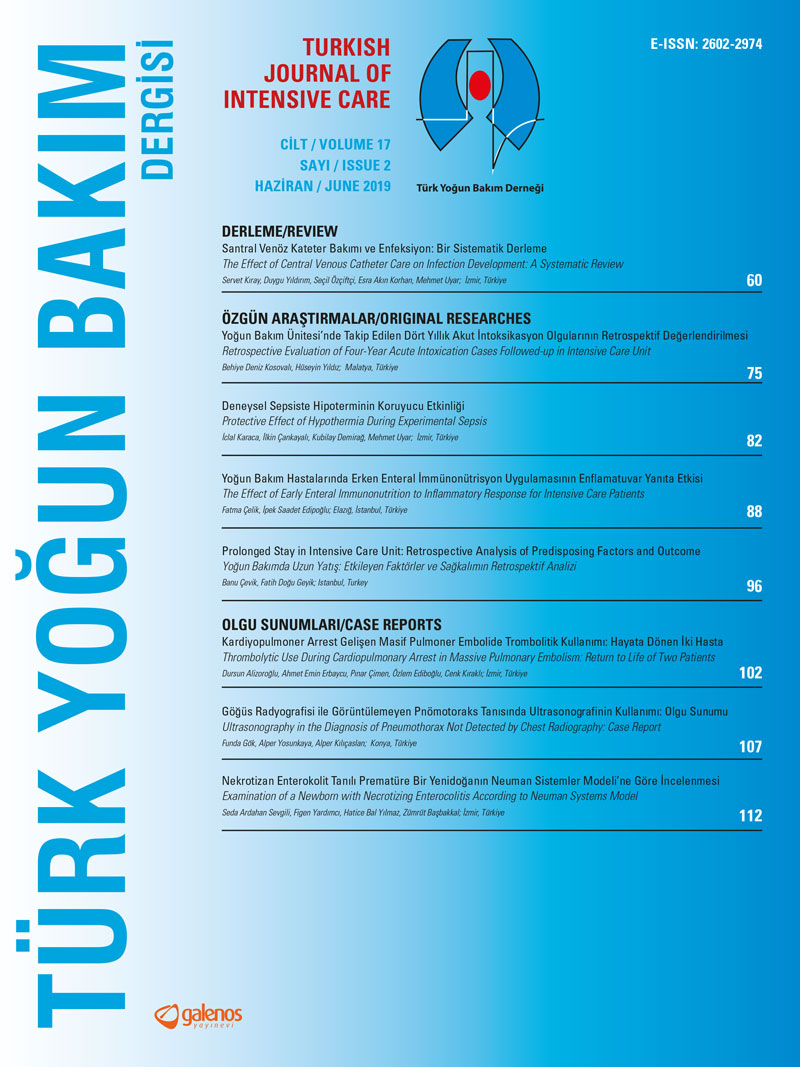Öz
Amaç:
Bu çalışma, santral venöz kateter bakımında kullanılan yöntemlerin santral venöz kateter ilişkili enfeksiyona etkisini belirlemek amacı ile sistematik bir şekilde gerçekleştirilmiştir.
Gereç ve Yöntem:
Bu sistematik derlemede; “Google Scholar, Pubmed, Science Direct, Proquest, Cochrane Library, ULAKBİM, EBSCOhost ve Google Akademik olmak üzeri 8 veri tabanından ulaşılabilen, 1 Ocak 2007-15 Aralık 2017 tarihleri arasında yapılan araştırmalar incelenmiştir. Çalışmada Türkçe ve İngilize olarak “bakım”, “santral venöz kateter”, “enfeksiyon”, “kateter ilişkili enfeksiyon”, “kateterizasyon” anahtar kelimeleri kullanılmıştır. Bu bağlamda; araştırmaya dahil edilme kriterlerine uyan ulusal ve uluslararası çalışmalar taranmış olup, 40 yayın çalışma kapsamında değerlendirilmiştir.
Bulgular:
Sistematik derlemeye dahil edilen araştırmaların 11’i prospektif, 8’i randomize kontrollü deneysel, 5’i retrospektif, 3’ü gözlemsel, 3’ü tanımlayıcı, 3’ü yarı deneysel, 2’si prospektif randomize kontrollü deneysel, diğerleri ise prospektif-gözlemsel-girişimsel-kesintili zaman serileri, metodolojik, kesitsel, tek gruplu ön test-son test yarı deneysel, retrospektif-yarı deneysel araştırma tasarımına sahiptir. Elde edilen araştırma sonuçlarına göre %2, %4 klorheksidin, povidon iyot, oktenidin hidrokloritinin deri antisepsisinde kullanıldığı; katater yerleştirme ve bakımına ilişkin bakım paketlerinin kullanıldığı; klorheksidin glukonat emdirilmiş sünger sargı, poliüretan şeffaf film örtü, gazlı bez ve mikro gözenekli bantların santral venöz kateter pansumanında; klorheksidinin hasta banyosunda kullanıldığı tespit edilmiştir.
Sonuç:
Klorheksidin solüsyonunun deri antisepsisinde ve hasta banyosunda kullanılmasının, klorheksidin emdirilmiş sünger sargıların ve şeffaf film örtülerin kateter alanının kapatılmasında kullanılmasının kateter ilişkili enfeksiyon insidansını düşürebileceği sonucuna varılmıştır. Ayrıca hastalara, çeşitli disiplinler tarafından oluşturulan santral venöz kateter bakım paketlerinin uygulanmasının etkili hemşirelik bakım uygulamaları arasında olduğu ve kateter ilişkili enfeksiyonun önlenmesinde yararlı olabileceği düşünülmektedir.
Anahtar Kelimeler: Bakım, enfeksiyon, hemşirelik, santral venöz kateter
Referanslar
- Gürsoy B, Gelecek S, Yorgancı K. Santral venöz kateter infeksiyonları. Yoğun Bakım Dergisi 2006;6:196-203.
- Pektaş A, Kara A, Gurgey A. Cohort study: Cohort Study: Central Venous Catheter-Related Complications in Children with Hematologic Diseases at a Single Center. Turk J Haematol 2015;32:144-51.
- Deşer SB, Demirağ MK, Zengin S. Santral venöz kateterizasyon sonrasında sağ brakiyosefalik venin perforasyonu: Olgu sunumu. Turk Gogus Kalp Dama 2015;23:570-3.
- Asch MR. Venous access: options, approaches and issues. Can Assoc Radiol J 2001;52:153-64.
- Weber DJ, Rutala WA. Central line-associated bloodstream infections: prevention and management. Infect Dis Clin North Am 2011;25:77-102.
- Ge X, Cavallazzi R, Li C, et al. Central venous access sites for the prevention of venous thrombosis, stenosis and infection. Cochrane Database Syst Rev 2012;CD004084.
- Şanlı D, Sarıkaya A. Santral venöz kateterde kanıta dayalı hemşirelik bakım yönetimi. Yoğun Bakım Hemşireliği Dergisi 2016;20:84-97.
- The Joint Commission (TJC). Preventing central line-associated bloodstream infections: a global challenge, a global perspective. 2012. Available from: http://www.PreventingCLABSIs.pdf
- Institute for Healthcare Improvement (IHI). How-to guide: Prevent central line-associated bloodstream infections (CLABSI). 2012. Available from: http://www.ihi.org/resources/pages/tools/howtoguidepr event centrallineassociated blood stream infection.aspx
- Çetinkaya Şardan Y, Güner R, Çakar N, Ağalar F, Bolaman Z, Yavaşoğlu İ, ve ark. Türk Hastane İnfeksiyonları ve Kontrolü Derneği (HİDER). Damar İçi Kateter İnfeksiyonlarının Önlenmesi Kılavuzu. Hastane İnfeksiyonları Dergisi 2013;17:1-56.
- Curry S, Honeycutt M, Goins G, et al. Catheter-associated bloodstream infections in the NICU: getting to zero. Neonatal Netw 2009;28:151-5.
- Ishizuka M, Nagata H, Takagi K, et al. Femoral venous catheterization is a major risk factor for central venous catheter-related bloodstream infection. J Invest Surg 2009;22:16-21.
- Bilir A, Yelken B, Erkan A. Cholorhexidine, octenidine or povidone iodine for catheter related infections: A randomized controlled trial. J Res Med Sci 2013;18:510-2.
- Yamamoto N, Kimura H, Misao H, et al. Efficacy of 1.0% chlorhexidine-gluconate ethanol compared with 10% povidone-iodine for long-term central venous catheter care in hematology departments: a prospective study. Am J Infect Control 2014;42:574-6.
- Kao HF, Chen IC, Hsu C, et al. Chlorhexidine for the prevention of bloodstream infection associated with totally implantable venous ports in patients with solid cancers. Support Care Cancer 2014;22:1189-97.
- Mimoz O, Lucet JC, Kerforne T, et al. Skin antisepsis with chlorhexidine-alcohol versus povidone iodine-alcohol, with and without skin scrubbing, for prevention of intravascular-catheter-related infection (CLEAN): an open-label, multicentre, randomised, controlled, two-by-two factorial trial. Lancet 2015;386:2069-2077.
- Hatler C, Buckwald L, Salas-Allison Z, et al. Evaluating central venous catheter care in a pediatric intensive care unit. Am J Crit Care 2009;18:514-20.
- Silveira RC, Braga FT, Garbin LM, et al. The use of polyurethane transparent film in indwelling central venous catheter. Rev Lat Am Enfermagem 2010;18:1212-20.
- Timsit JF, Schwebel C, Bouadma L, et al. Chlorhexidine-impregnated sponges and less frequent dressing changes for prevention of catheter-related infections in critically ill adults: a randomized controlled trial. JAMA 2009;301:1231-41.
- Pfaff B, Heithaus T, Emanuelsen M. Use of a 1-piece chlorhexidine gluconate transparent dressing on critically ill patients. Crit Care Nurse 2012;32:35-40.
- Kaya H, Turan Y, Akbal S, ve ark. The effect of nursing care protocol on the prevention of central venous catheter-related infections in neurosurgery intensive care unit. Appl Nurs Res 2016;32:257-61.
- Arpa Y, Aygün H, Yalçınbaş Y, ve ark. Santral kateter bakımında şeffaf örtü ve klorheksidin glukonat emdirilmiş şeffaf örtü kullanılan pediyatrik kardiyovasküler cerrahi hastalarının kateter ilişkili enfeksiyon oranlarının karşılaştırılması. Turkish Journal of Research & Development in Nursing 2013;15:57-67.
- Pedrolo E, Danski MTR, Vayego SA. Chlorhexidine and gauze and tape dressings for central venous catheters: a randomized clinical trial. Rev Lat Am Enfermagem 2014;22:764-71.
- Ruschulte H, Franke M, Gastmeier P, et al. Prevention of central venous catheter related infections with chlorhexidine gluconate impregnated wound dressings: a randomized controlled trial. Ann Hematol 2009;88:267-72.
- Timsit JF, Mimoz O, Mourvillier B, et al. Randomized controlled trial of chlorhexidine dressing and highly adhesive dressing for preventing catheter-related infections in critically ill adults. Am J Respir Crit Care Med 2012;186:1272-8.
- Arvaniti K, Lathyris D, Clouva-Molyvdas P, et al. Comparison of Oligon catheters and chlorhexidine-impregnated sponges with standard multilumen central venous catheters for prevention of associated colonization and infections in intensive care unit patients: a multicenter, randomized, controlled study. Crit Care Med 2012;40:420-9.
- Bizzarro MJ, Sabo B, Noonan M, et al. A quality improvement initiative to reduce central line-associated bloodstream infections in a neonatal intensive care unit. Infect Control Hosp Epidemiol 2010;31:241-8.
- Longmate AG, Ellis KS, Boyle L, et al. Elimination of central-venous-catheter-related bloodstream infections from the intensive care unit. BMJ Qual Saf 2011;20:174-80.
- Guerin K, Wagner J, Rains K, et al. Reduction in central line-associated bloodstream infections by implementation of a postinsertion care bundle. Am J Infect Control 2010;38:430-3.
- Rey C, Alvarez F, De-La-Rua V, et al. Intervention to reduce catheter-related bloodstream infections in a pediatric intensive care unit. Intensive Care Med 2011;37:678-85.
- Jeong IS, Park SM, Lee JM, et al. Effect of central line bundle on central line-associated bloodstream infections in intensive care units. Am J Infect Control 2013;41:710-6.
- Salama MF, Jamal W, Al Mousa H, et al. Implementation of central venous catheter bundle in an intensive care unit in Kuwait: Effect on central line-associated bloodstream infections. J Infect Public Health 2016;9:34-41.
- Duane TM, Brown H, Borchers CT, et al. A central venous line protocol decreases bloodstream infections and length of stay in a trauma intensive care unit population. Am Surg 2009;75:1166-70.
- Polat F, Şahinoğlu AH, Dilek A, ve ark. Rehberlere Dayalı Önlem ve Bakım Paketlerinin Yoğun Bakım Ünitesinde Santral Venöz Kateter Enfeksiyonları Üzerine Etkisi. Türk Yogun Bakim Dernegi Dergisi 2014;12:86-93.
- Grigonis AM, Dawson AM, Burkett M, et al. Use of a Central Catheter Maintenance Bundle in Long-Term Acute Care Hospitals. Am J Crit Care 2016;25:165-72.
- McPeake J, Cantwell S, Booth MG, et al. Central line insertion bundle: experiences and challenges in an adult ICU. Nurs Crit Care 2012;17:123-9.
- Butler-O’Hara M, D’Angio CT, Hoey H, et al. An evidence-based catheter bundle alters central venous catheter strategy in newborn infants. J Pediatr 2012;160:972-7.e2.
- Cesaro S, Cavaliere M, Pegoraro A, et al. A comprehensive approach to the prevention of central venous catheter complications: results of 10-year prospective surveillance in pediatric hematology-oncology patients. Ann Hematol 2016;95:817-25.
- Entesari-Tatafi D, Orford N, Bailey MJ, et al. Effectiveness of a care bundle to reduce central line-associated bloodstream infections. Med J Aust 2015;202:247-50.
- Lin KY, Cheng A, Chang YC, et al. Central line-associated bloodstream infections among critically-ill patients in the era of bundle care. J Microbiol Immunol Infect 2017;50:339-48.
- Bleasdale SC, Trick WE, Gonzalez IM, et al. Effectiveness of chlorhexidine bathing to reduce catheter-associated bloodstream infections in medical intensive care unit patients. Arch Intern Med 2007 Oct 22;167:2073-9.
- Dixon JM, Carver RL. Daily chlorohexidine gluconate bathing with impregnated cloths results in statistically significant reduction in central line-associated bloodstream infections. Am J Infect Control 2010;38:817-21.
- Montecalvo MA, McKenna D, Yarrish R, et al. Chlorhexidine bathing to reduce central venous catheter-associated bloodstream infection: impact and sustainability. Am J Med 2012;125:505-11.
- Munoz-Price LS, Dezfulian C, Wyckoff M, et al. Effectiveness of stepwise interventions targeted to decrease central catheter-associated bloodstream infections. Crit Care Med 2012;40:1464-9.
- Telli G, Dizbay M, Güzel ÖT, ve ark. Klorheksidinli swap-stick ve klorheksidin emdirilmiş transparan örtü kullanımı ile kateter ilişkili kan dolaşımı enfeksiyonlarının önlenmesi. Gazi Medical Journal 2015;26:152-4.
- Edwards JD, Herzig CT, Liu H, et al. Central line-associated blood stream infections in pediatric intensive care units: Longitudinal trends and compliance with bundle strategies. Am J Infect Control 2015;43:489-93.
- Parás-Bravo P, Paz-Zulueta M, Sarabia-Lavin R, at al. Complications of Peripherally Inserted Central Venous Catheters: A Retrospective Cohort Study. PLoS One 2016;11:e0162479.
- Mirabel-Chambaud E, N’Guyen M, Valdeyron ML, et al. Dramatic increase of central venous catheter-related infections associated with a high turnover of the nursing team. Clin Nutr 2016;35:446-52.
- Lee DH, Jung KY, Choi YH. Use of maximal sterile barrier precautions and/or antimicrobial-coated catheters to reduce the risk of central venous catheter-related bloodstream infection. Infect Control Hosp Epidemiol 2008;29:947-50.
- Carter JH, Langley JM, Kuhle S, et al. Risk Factors for Central Venous Catheter-Associated Bloodstream Infection in Pediatric Patients: A Cohort Study. Infect Control Hosp Epidemiol 2016;37:939-45.
- Ohtake O, Takahashia H, Nakagawaa M, et al. One percent chlorhexidine-alcohol for preventing central venous catheter-related infection during intensive chemotherapy for patients with haematologic malignancies. J Infect Chemother 2018;24:544-8.
- Heimann SM, Biehl LM, Vehreschild JJ, et al. Chlorhexidine-containing dressings in the prevention of central venous catheter-related bloodstream infections: A cost and resource utilization analysis. Am J Infect Control 2018;46:992-7.
- Pivkina AI, Gusarov VG, Blot SI, et al. Effect of an acrylic terpolymer barrier film beneath transparent catheter dressings on skin integrity, risk of dressing disruption, catheter colonisation and infection. Intensive Crit Care Nurs 2018;46:17-23.
- Kumar T, Kumar M, Saurabh K, Ansari AA. Comparıson Between Central Venous Catheter Securement Dressıng Wıth Chlorhexıdıne Gluconate Dressıng And Elastıc Adhesıve Dressıng In Incıdence Of Crbsı And Catheter Dıslodgement In Icu Patıent: A Retrospectıve Study. Internatıonal Journal Of Scıentıfıc Research 2018;7.
- Lee KH, Cho NH, Jeong SJ, et al. Effect of Central Line Bundle Compliance on Central Line-Associated Bloodstream Infections. Yonsei Med J 2018;59:376-82.
- Yazici G, Bulut H. Efficacy of a care bundle to prevent multiple infections in the intensive care unit: A quasi-experimental pretest-posttest design study. Appl Nurs Res 2018;39:4-10.
- Urbancic KF, Martensson J, Glassford N, et al. Impact of unit-wide chlorhexidine bathing in intensive care on bloodstream infection and drug-resistant organism acquisition. Crit Care Resusc 2018;20:109-16.
Telif hakkı ve lisans
Telif hakkı © 2019 Yazar(lar). Açık erişimli bu makale, orijinal çalışmaya uygun şekilde atıfta bulunulması koşuluyla, herhangi bir ortamda veya formatta sınırsız kullanım, dağıtım ve çoğaltmaya izin veren Creative Commons Attribution License (CC BY) altında dağıtılmıştır.






















